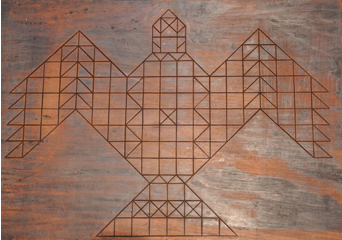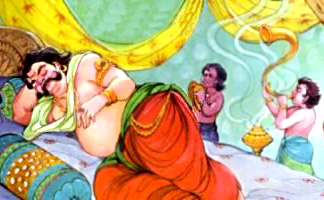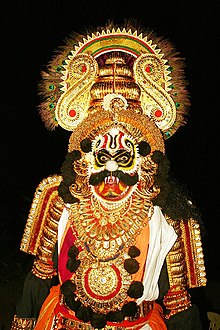The antiquity of idol worship.
The vedic way of worshiping Gods is through yajna. However indications of image worship can be seen even in vedic scriptures. Some examples are :
Aitareya brahmanam says
चक्षुषा वा एतत्प्रज्ञायते यदप्रज्ञेयम्
What is not perceivable is perceived by the eyes. Whatever is perceived by the eyes is what is visible.
Imagery is part and parcel of vedic worship. In yajna, the altar and every instrument used is a divinity, they are addressed and communicated with. For the Hindu, they are not inanimate objects but expressions of divinity. Texts called Shulba sutras describe the making of all these.
For making a ladle with which ahutis of ghee are offered in Agni, it is specified what wood it should be made of, its length, holding capacity, the shape ( should look like the lower lip of an elephant ) and even direction in which it should be carved.
In the vedic yajna called Atiratram, a yajna vedi is constructed in the form of Shyena the great bird.It involves great precision and elaborate rituals.

Imagery is part and parcel of vedic worship. In yajna, the altar and every instrument used is a divinity, they are addressed and communicated with. For the Hindu, they are not inanimate objects but expressions of divinity. Texts called Shulba sutras describe the making of all these.
For making a ladle with which ahutis of ghee are offered in Agni, it is specified what wood it should be made of, its length, holding capacity, the shape ( should look like the lower lip of an elephant ) and even direction in which it should be carved.
In the vedic yajna called Atiratram, a yajna vedi is constructed in the form of Shyena the great bird.It involves great precision and elaborate rituals.


A large portion of the Rigveda mantras consists of praises of Gods which are essentially descriptions of their form and great deeds.
It is considered that temples are essential part of the ancient town planning.
Agni Puranam ( 109.16-17 ) says that temples of Indra, Vishnu etc. should be built in cities / towns for their protection. Cities, villages, forts and houses where such divine presence is not there are open to attack by diseases and evil spirits.
Agni puranam 38 & 327.96 describe the importance of construction of temples and the results therefrom.
Vishnu Dharmottara puranam ( 3.93.6-7 ) says that the king desirous of heaven should always build cities with temples in Kali Yuga.
Apastamba Dharma Sutra ( 1.11.30.22 ) prohibits stretching of legs in the direction of Gods. It is clear that it is not the omnipresent which is intended here, otherwise there will not be any place left to stretch the legs.
Brihat Samhita of Varahamihiracharya describes the places suitable for construction of temples.
Which is the shastra that governs idol and temple worship in Hinduism ?
Agama shastra.
They are broadly classified into Shaiva, Vaishnava, Shakta, Ganapathya, Kaumara etc. They deal with spiritual knowledge, philosophy, rituals and sculpture / architecture related to idol and temple worship. These texts are arranged in four sections-
1. Kriya pada - deals with temple architecture. construction, sculpture of idols and consecration of temples.
2. Charya pada - deals with rules of daily worship, procedures, festivals and penances.
3. Yoga pada - idol worship is based on the principles of kundalini yoga. The co relations are detailed here.
4. Jnana / vidya pada - `the high philosophical principles of idol worship are explained here.
The enormity of this shastra can be perceived from the fact that the kriya pada alone of one text called Kamikagama consists of 12000 verses. There are hundreds of such texts pertaining to each deity.
Just to get an idea of what these texts look like go to
Why idol worship ?
1. Vishnu Samhita 29.55 says
न च रूपं विना देवं ध्यातुं केनापि शक्यते ।
It is impossible to meditate on God without a form
2. Vishnudharmottara puranam 3.108.23 says
अनाकारे महाराज लक्ष्यबन्धस्तु दुष्करः ।
It is very difficult to focus on the formless.
3. Vishnudharmottara puranam 3.46.3 says
पूजाध्यानादिकं कर्तुं साकारस्यैव शक्यते ।
Only the one with form can be worshiped or meditated upon.
3. Vishnudharmottara puranam 3.108.26-27 and Padmapuranam 6.132.105 say that only one who has achieved success in meditating upon God with form can contemplate the form less.
4. Devi bhagavata puranam 7.39.43 says
यावदान्तरपूजायामधिकारो भवेन्नहि।
तावद्बाह्यमिमां पूजां श्रयेज्जाते तु तां त्यजेत् ॥
Until such time one achieves the eligibility to perform inner worship the outer worship should be performed.
5. Vishnudharmottara puranam 3.93.21-22 says
अर्चास्थैस्त्रिदशैर्लोकः कलौ सर्वो हि पाल्यते ।
अर्चागताश्च गृह्णन्ति कृतदेवप्रतिष्ठिताः ।
तस्मात् कलौ प्रयत्नेन प्रतिष्ठाकरणं हितम् ॥
In Kaliyuga, gods stay in idols to protect and govern the world. They receive whatever is offered to the idols. Hence consecration of idols should be necessarily done in Kali yuga.
Idol as a model
Science makes use of models very extensively. In Science, a three dimensional representation of a person, object or structure is called a model. Imagine learning geography without the globe, anatomy without models. Imagine learning engineering without actually seeing the machines, engines, structures etc.
Why all this fuss when it comes to images in religion ? We are dealing with saguna and sakara form of the divine here.
Stone vs. Idol
The statue made of stone or other prescribed materials attains divinity upon performing prana pratishta. To ridicule it by saying "pathar pujan" is total ignorance.
An ordinary man is given the police uniform and authority. Doesn't power to command naturally come to him ? An ordinary piece of clothe painted with tricolor - does it not command respect ?
Likewise, an idol becomes a living God for the devotee whom he can communicate with.
Prana pratishta
The divinity is infused into the idol by a procedure called prana pratishta.
Kalikapuranam 88.10-12 says
अकृतायां प्रतिष्ठायां प्राणानां प्रतिमासु च ।
यथापूर्वं तथाभावः स्वर्णादीनां न विष्णुता ॥
In the absence of prana pratishta the idols remain just the materials they are.
In Hayagriva samhita it is said,
अर्चकस्य तपोयोगातदर्चनस्यातिशायनात् ।
आभिरूप्याच्च बिम्बानां देवः सान्निध्यमृच्छति ॥
The tapas of the worshiper, perfection of the rituals and appropriateness ( in terms of beauty and precision ) of the idol - these are the factors that bring in divine presence in the idol.
It is not within the scope of this small write up to elaborate on the technicalities of temple construction and idol worship. There are hundreds of acclaimed texts each running into thousands of pages for reference.
These were not written with the purpose of earning royalty from sales or for winning the best seller title. They were written and handed down from generation to generation because they stand for the truth.
It is not as simple as planting a stone somewhere, applying some color over it, putting some money in front of it and multiplying your investment in hours.
As Matthew Mcallister commented on the philanthropic facade of sponsored art - " art is yanked from its own separate and theoretically autonomous domain and squarely placed in the commercial,,,,,"
Idol worship, for that matter every aspect of Hindu religion or Sanatana Dharma has come under attack and criticism both from inside and outside. Hinduism is not a single agenda movement. It is an assimilation of apparently vastly varying religious and spiritual thoughts and practices. The critics can be broadly classified into three groups.
1. People with knowledge and conviction about religion, spirituality and Gods propounding a certain system of thought and testing its mettle against other contemporary systems. Shankara's digvijaya yatra during which he entered into scholastic debates with expert authorities in Meemasa, Sankhya etc. in order to establish the superiority of vedanta is an example.
2. Those seeking to have a following of their own by any means.
3. The business minded who want to make a quick buck out of the controversy and attention they generate.
The sad part is that Hindus through their decades of intellectual slavery have lost track of who they are, what their values are and especially what their religion is all about.
Crores and crores of devotees have attained divine benevolence through idol and temple worship. More than 19 million devotees visit Tirupati every year. Close to a million people undertook Badrinath pilgrimage in 2012. alone.
There are hundreds of thousands of temples all over the world. Does it make any sense brushing aside murhty puja as senseless ?
Can it be viewed as only entertainment ? Yes, of course ! That is also my personal view. We have been laughing out loud at the jokes Laurel & Hardy ( "this sea is infatuated with sharks" ) , the comic actions of Tom & Jerry. Why not another lovable alien ??
That is as much as it deserves.





